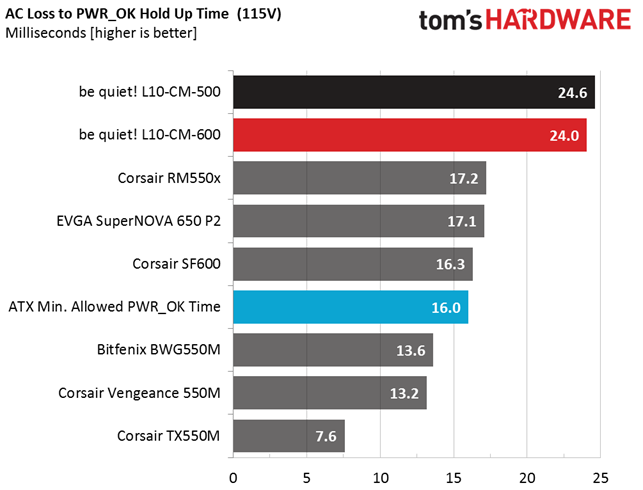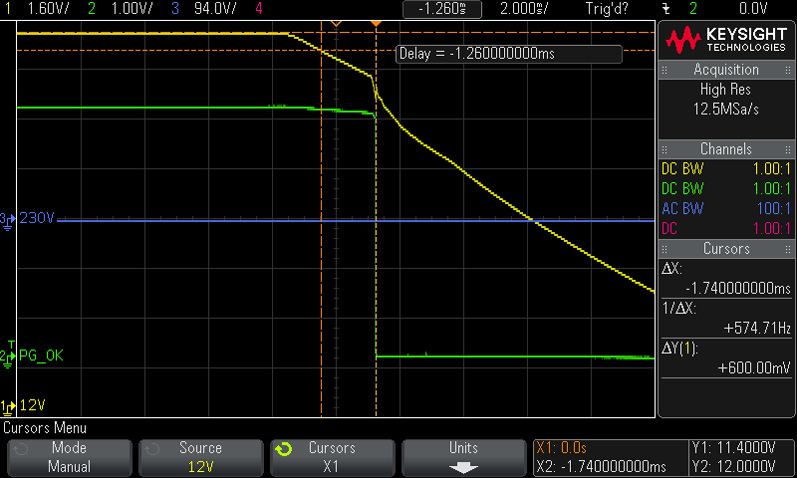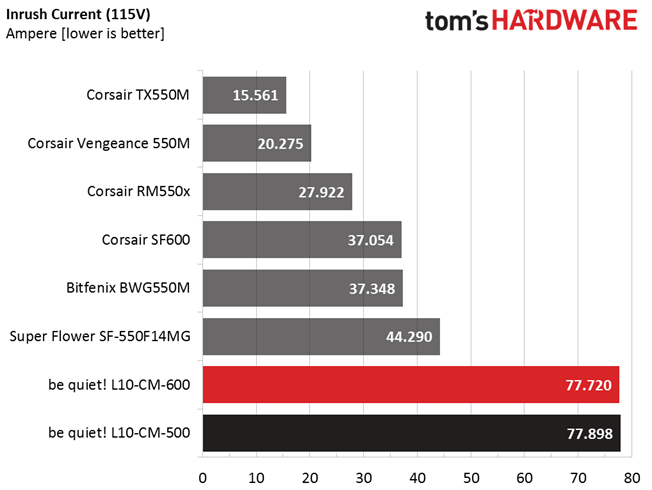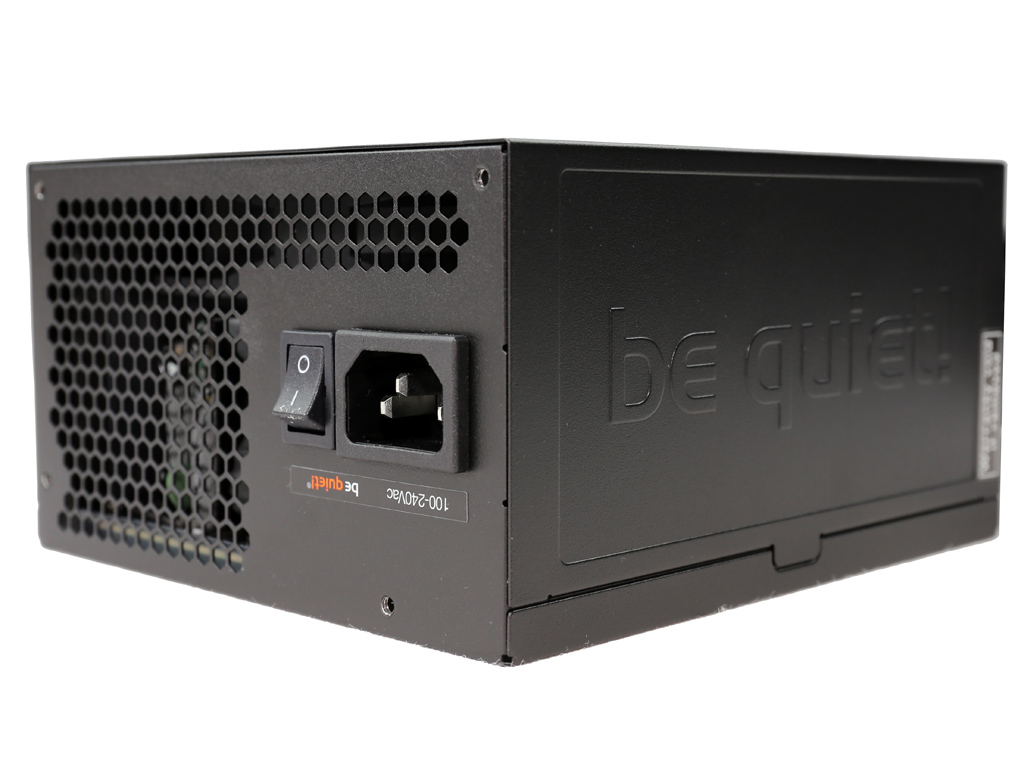be quiet! Pure Power 10 600W PSU Review
Why you can trust Tom's Hardware
Load Regulation, Hold-Up Time & Inrush Current
To learn more about our PSU tests and methodology, please check out How We Test Power Supply Units.
Primary Rails And 5VSB Load Regulation
Load Regulation testing is detailed here.








Hold-Up Time
Our hold-up time tests are described in detail here.







The hold-up time we measured is surprisingly long. However, the power-good signal is inaccurate since it drops when the +12V rail is already out of spec (meaning that its voltage is lower than 11.4V).
Inrush Current
For details on our inrush current testing, please click here.


Inrush current is significantly lower than last generation's 600W model. The graphs above clearly show how the addition of a small component like an NTC thermistor affects (in a good way) this metric.
Load Regulation And Efficiency Measurements
The first set of tests reveals the stability of the voltage rails and the L10-CM-600's efficiency. The applied load equals (approximately) 10 to 110 percent of the PSU's maximum load in increments of 10 percentage points.
Get Tom's Hardware's best news and in-depth reviews, straight to your inbox.
We conducted two additional tests. During the first, we stressed the two minor rails (5V and 3.3V) with a high load, while the load at +12V was only 0.1A. This test reveals whether a PSU is compatible with Intel's C6/C7 sleep states or not. In the second test, we determined the maximum load the +12V rail could handle with minimal load on the minor rails.
| Test # | 12V | 5V | 3.3V | 5VSB | DC/AC (Watts) | Efficiency | Fan Speed | Fan Noise | Temps (In/Out) | PF/AC Volts |
|---|---|---|---|---|---|---|---|---|---|---|
| 1 | 3.145A | 1.980A | 1.958A | 0.985A | 59.772 | 83.428% | 568 RPM | 17.4 dB(A) | 38.23°C | 0.964 |
| 12.147V | 5.050V | 3.364V | 5.061V | 71.645 | 41.57°C | 115.11V | ||||
| 2 | 7.327A | 2.970A | 2.946A | 1.187A | 119.772 | 88.196% | 568 RPM | 17.4 dB(A) | 38.72°C | 0.980 |
| 12.136V | 5.042V | 3.355V | 5.049V | 135.802 | 42.21°C | 115.11V | ||||
| 3 | 11.861A | 3.481A | 3.462A | 1.385A | 179.884 | 89.548% | 568 RPM | 17.4 dB(A) | 39.17°C | 0.987 |
| 12.126V | 5.029V | 3.344V | 5.036V | 200.881 | 43.08°C | 115.10V | ||||
| 4 | 16.392A | 3.982A | 3.949A | 1.591A | 239.782 | 89.733% | 568 RPM | 17.4 dB(A) | 39.37°C | 0.992 |
| 12.117V | 5.021V | 3.336V | 5.024V | 267.216 | 44.21°C | 115.10V | ||||
| 5 | 20.587A | 4.985A | 4.952A | 1.796A | 299.681 | 89.357% | 568 RPM | 17.4 dB(A) | 40.19°C | 0.995 |
| 12.107V | 5.010V | 3.325V | 5.008V | 335.376 | 45.76°C | 115.10V | ||||
| 6 | 24.800A | 5.997A | 5.960A | 2.001A | 359.724 | 88.708% | 568 RPM | 17.4 dB(A) | 41.16°C | 0.997 |
| 12.096V | 5.000V | 3.316V | 4.995V | 405.514 | 47.89°C | 115.11V | ||||
| 7 | 29.016A | 7.014A | 6.979A | 2.204A | 419.656 | 87.840% | 910 RPM | 19.7 dB(A) | 41.90°C | 0.998 |
| 12.084V | 4.988V | 3.304V | 4.983V | 477.750 | 48.92°C | 115.11V | ||||
| 8 | 33.234A | 8.042A | 8.003A | 2.414A | 479.596 | 87.025% | 1165 RPM | 22.3 dB(A) | 42.98°C | 0.998 |
| 12.074V | 4.973V | 3.291V | 4.970V | 551.101 | 49.98°C | 115.10V | ||||
| 9 | 37.898A | 8.554A | 8.544A | 2.415A | 539.660 | 85.991% | 1380 RPM | 26.6 dB(A) | 43.63°C | 0.998 |
| 12.063V | 4.965V | 3.282V | 4.963V | 627.575 | 51.01°C | 115.10V | ||||
| 10 | 42.307A | 9.079A | 9.056A | 3.030A | 599.494 | 84.694% | 1600 RPM | 31.6 dB(A) | 44.44°C | 0.998 |
| 12.053V | 4.954V | 3.270V | 4.943V | 707.836 | 52.52°C | 115.12V | ||||
| 11 | 47.325A | 9.089A | 9.074A | 3.034A | 659.457 | 83.289% | 1685 RPM | 32.6 dB(A) | 45.55°C | 0.998 |
| 12.042V | 4.948V | 3.263V | 4.940V | 791.770 | 54.49°C | 115.12V | ||||
| CL1 | 0.101A | 17.022A | 17.004A | 0.004A | 142.348 | 79.857% | 935 RPM | 19.7 dB(A) | 43.27°C | 0.985 |
| 12.115V | 4.985V | 3.308V | 5.040V | 178.253 | 49.27°C | 115.10V | ||||
| CL2 | 48.307A | 1.003A | 1.003A | 1.002A | 596.137 | 84.638% | 1535 RPM | 30.0 dB(A) | 44.45°C | 0.998 |
| 12.065V | 4.979V | 3.295V | 5.005V | 704.340 | 51.71°C | 115.11V |
Load regulation is much tighter than the previous generation and pretty good at +12V, while it's within 3% on the other rails. ACRF topologies don't usually offer good load regulation. But this platform overcomes that shortcoming, and thanks to the DC-DC converters, performance on the CL tests is good as well.
The fan profile isn't aggressive, even at operating temperatures higher than 40°C. It's only during the full load and overload tests that the fan's noise exceeds 30 dB(A).
MORE: Best Power Supplies
MORE: How We Test Power Supplies
MORE: All Power Supply Content
Current page: Load Regulation, Hold-Up Time & Inrush Current
Prev Page Teardown & Component Analysis Next Page Efficiency, Temperature & Noise
Aris Mpitziopoulos is a contributing editor at Tom's Hardware, covering PSUs.
-
sunny420 This one looks like a pass. Much better units out there. Too bad, I wish the best for BeQuiet!Reply
Another review:
https://www.hardocp.com/article/2017/06/27/be_quiet_pure_power_10_600w_supply_review -
HERETIC-1 For not too many $ more you can get a Seasonic G series.Reply
With quality components-better design-better performance,
and to top it off a longer warranty................................
PSU IS THE MOST IMPORTANT PART OF ANY BUILD.
Avoid these low end PSU's......................


